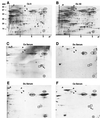Clustering of clinical strains of Helicobacter pylori analyzed by two-dimensional gel electrophoresis
- PMID: 10702510
- PMCID: PMC95866
- DOI: 10.1128/CDLI.7.2.301-306.2000
Clustering of clinical strains of Helicobacter pylori analyzed by two-dimensional gel electrophoresis
Abstract
Strain variations of Helicobacter pylori have been tested by numerous methods and compared among different patient groups. The aim of this study was to investigate whether H. pylori expresses disease-specific proteins that can be detected by two-dimensional polyacrylamide gel electrophoresis (2-D PAGE). H. pylori strains isolated from duodenal ulcer, gastric cancer, and gastritis patients were analyzed. Extensive variation in spot patterns was observed between the strains, but a dendrogram analysis revealed that some strains within each disease group clustered together. Eight proteins were sequenced and found in the H. pylori genome sequence. 2-D PAGE is a useful method for studies of protein expression and for highlighting the extensive strain variation that H. pylori exhibits.
Figures



Similar articles
-
Comparative analysis of two-dimensional electrophoresis maps (2-DE) of Helicobacter pylori from Brazilian patients with chronic gastritis and duodenal ulcer: a preliminary report.Rev Inst Med Trop Sao Paulo. 2006 May-Jun;48(3):175-7. doi: 10.1590/s0036-46652006000300011. Epub 2006 Jul 5. Rev Inst Med Trop Sao Paulo. 2006. PMID: 16847509
-
Quantitative analysis of representative proteome components and clustering of Helicobacter pylori clinical strains.Helicobacter. 2006 Dec;11(6):533-43. doi: 10.1111/j.1523-5378.2006.00456.x. Helicobacter. 2006. PMID: 17083375
-
Comparative proteomics and immunoproteomics of Helicobacter pylori related to different gastric pathologies.J Chromatogr B Analyt Technol Biomed Life Sci. 2006 Mar 20;833(1):63-79. doi: 10.1016/j.jchromb.2005.12.052. Epub 2006 Feb 17. J Chromatogr B Analyt Technol Biomed Life Sci. 2006. PMID: 16483854
-
[Helicobacter pylori--introduction and review of research].Lijec Vjesn. 2002 Sep;124 Suppl 1:1-5. Lijec Vjesn. 2002. PMID: 12592806 Review. Polish.
-
Role of dupA in virulence of Helicobacter pylori.World J Gastroenterol. 2016 Dec 14;22(46):10118-10123. doi: 10.3748/wjg.v22.i46.10118. World J Gastroenterol. 2016. PMID: 28028359 Free PMC article. Review.
Cited by
-
Differential proteomics of Helicobacter pylori associated with autoimmune atrophic gastritis.Mol Med. 2014 Feb 28;20(1):57-71. doi: 10.2119/molmed.2013.00076. Mol Med. 2014. PMID: 24395566 Free PMC article.
-
Proteomic comparison of the cytosolic proteins of three Bifidobacterium longum human isolates and B. longum NCC2705.BMC Microbiol. 2010 Jan 29;10:29. doi: 10.1186/1471-2180-10-29. BMC Microbiol. 2010. PMID: 20113481 Free PMC article.
-
Comparative proteome analysis of Helicobacter pylori clinical strains by two-dimensional gel electrophoresis.J Zhejiang Univ Sci B. 2011 Oct;12(10):820-7. doi: 10.1631/jzus.B1000445. J Zhejiang Univ Sci B. 2011. PMID: 21960345 Free PMC article.
-
Comparative proteomic analysis of Lactobacillus plantarum for the identification of key proteins in bile tolerance.BMC Microbiol. 2011 Mar 29;11:63. doi: 10.1186/1471-2180-11-63. BMC Microbiol. 2011. PMID: 21447177 Free PMC article.
References
-
- Andersen H, Birkelund S, Christiansen G, Freundt E A. Electrophoretic analysis of proteins from Mycoplasma hominis strains detected by SDS-PAGE, two-dimensional gel electrophoresis and immunoblotting. J Gen Microbiol. 1987;133:181–191. - PubMed
-
- Blaser M J. In a world of black and white, Helicobacter pylori is grey. Ann Intern Med. 1999;130:695–697. - PubMed
-
- Blaser M J. Not all Helicobacter pylori strains are created equal: should all be eliminated? Lancet. 1997;349:1020–1022. - PubMed
-
- Cash P. The application of two-dimensional polyacrylamide gel electrophoresis to medical microbiology: molecular epidemiology of viruses and bacteria. Electrophoresis. 1991;12:592–604. - PubMed
Publication types
MeSH terms
Substances
LinkOut - more resources
Full Text Sources

